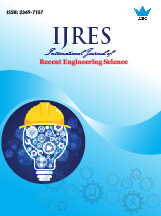Comparision on Codec Design for Reducing Energy Consumption in NOC
 |
International Journal of Recent Engineering Science (IJRES) |  |
| © 2015 by IJRES Journal | ||
| Volume-2 Issue-5 |
||
| Year of Publication : 2015 | ||
| Authors : P. Mahesh, DR . CH . Ravi Kumar |
||
| DOI : 10.14445/23497157/IJRES-V2I5P103 |
How to Cite?
P. Mahesh, DR. CH. Ravi Kumar, " Comparision on Codec Design for Reducing Energy Consumption in NOC," International Journal of Recent Engineering Science, vol. 2, no. 5, pp. 12-21, 2015. Crossref, https://doi.org/10.14445/23497157/IJRES-V2I5P103
Abstract
The aim of this thesis is a set of data encoding schemes are aimed at reducing power dissipated by the links of NOC. In this project three schemes are going to design by using VHDL code and simulate and compare in terms of a activity factor, power, area, delay and delay product. Coupling activity (Tc) plays the main role in the power model analysis which causes reduces power consumption in parallel NOC. An investigational result has shown the effectiveness of the proposed schemes, with respect of power dissipation and area overhead in the Network Interface (NI) as compared with data encoding which allows to save up to 54% of power dissipation and 11% of energy consumtion with out any significant performance degradation and with less than18% area overhead in the NI
Keywords
Coupling Switching Activity, Data Encoding, Inter Connect On Chip, Low Power, NOC, Power Analysis.
Reference
[1] Nima Jafarzadeh, Maurizio Palesi, Member, IEEE, Ahmad Khademzadeh, and Ali Afzali-Kusha, Senior Member, IEEE, ―Data Encoding Techniques for Reducing Energy Consumption in Network-on-Chip‖, IEEE Transactions on Very Large Scale Integration (VLSI) Systems, Vol. 22, No. 3, March 2014.
[2] International Technology Roadmap for Semiconductors. (2011) [Online]. Available: http://www.itrs.net.
[3] M. S. Rahaman and M. H. Chowdhury, ―Crosstalk avoidance and error correction coding for coupled RLC interconnects,‖ in Proc. IEEE Int. Symp. Circuits Syst., May 2009, pp. 141– 144.
[4] W. Wolf, A. A. Jerraya, and G. Martin, ―Multiprocessor system-on-chip MPSoC technology,‖ IEEE Trans. Comput.- Aided Design Integr. Circuits Syst., vol. 27, no. 10, pp. 1701–1713, Oct. 2008.
[5] L. Benini and G. De Micheli, ―Networks on chips: A new SoC paradigm,‖ Computer, vol. 35, no. 1, pp. 70–78, Jan. 2002.
[6] S. E. Lee and N. Bagherzadeh, ―A variable frequency link for a power aware network-on-chip (NoC),‖ Integr. VLSI J., vol. 42, no. 4, pp. 479–485, Sep. 2009.
[7] D. Yeh, L. S. Peh, S. Borkar, J. Darringer, A. Agarwal, and W. M. Hwu, ―Thousand-core chips roundtable,‖ IEEE Design Test Comput., vol. 25, no. 3, pp. 272–278, May–Jun. 2008.
[8] A. Vittal and M. Marek-Sadowska, ―Crosstalk reduction for VLSI,‖ IEEE Trans. Comput.-Aided Design Integr. Circuits Syst., vol. 16, no. 3, pp. 290–298, Mar. 1997.
[9] M. Ghoneima, Y. I. Ismail, M. M. Khellah, J. W. Tschanz, and V. De, ―Formal derivation of optimal active shielding for low-power on-chip buses,‖ IEEE Trans. Comput.-Aided Design Integr. Circuits Syst., vol. 25, no. 5, pp. 821–836, May 2006.
[10] L. Macchiarulo, E. Macii, and M. Poncino, ―Wire placement for crosstalk energy minimization in address buses,‖ in Proc. Design Autom. Test Eur. Conf. Exhibit., Mar. 2002, pp. 158– 162.
[11] R. Ayoub and A. Orailoglu, ―A unified transformational approach for reductions in fault vulnerability, power, and crosstalk noise and delay on processor buses,‖ in Proc. Design Autom. Conf. Asia South Pacific, vol. 2. Jan. 2005, pp. 729–734.
[12] K. Banerjee and A. Mehrotra, ―A power-optimal repeater insertion methodology for global interconnects in nanometer designs,‖ IEEE Trans. Electron Devices, vol. 49, no. 11, pp. 2001–2007, Nov. 2002.
